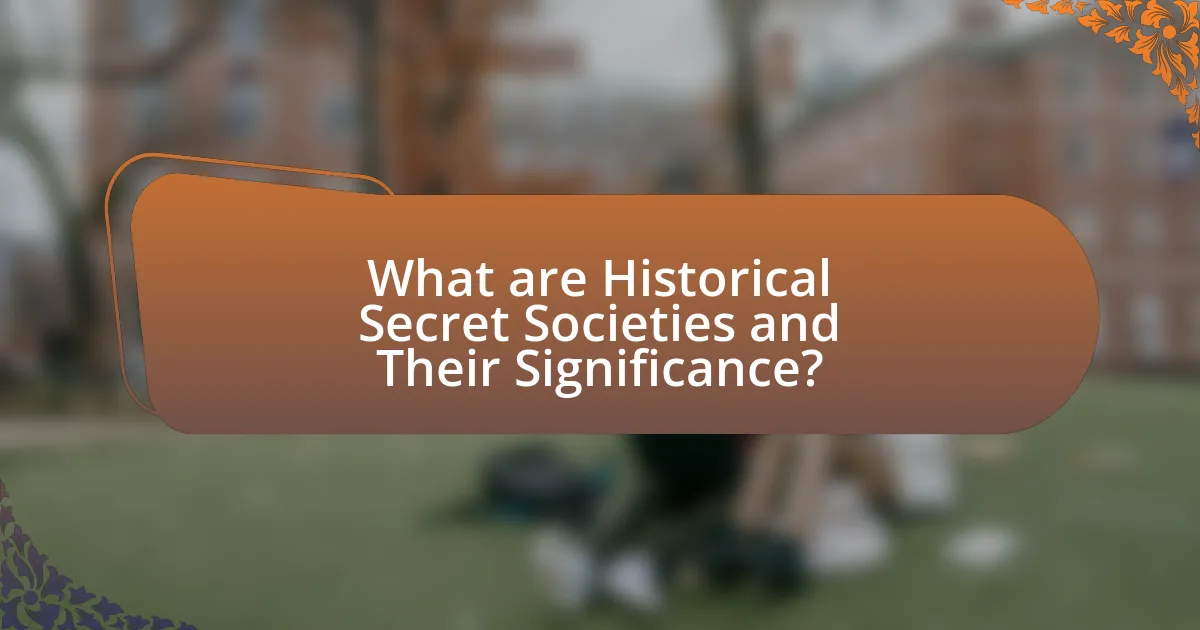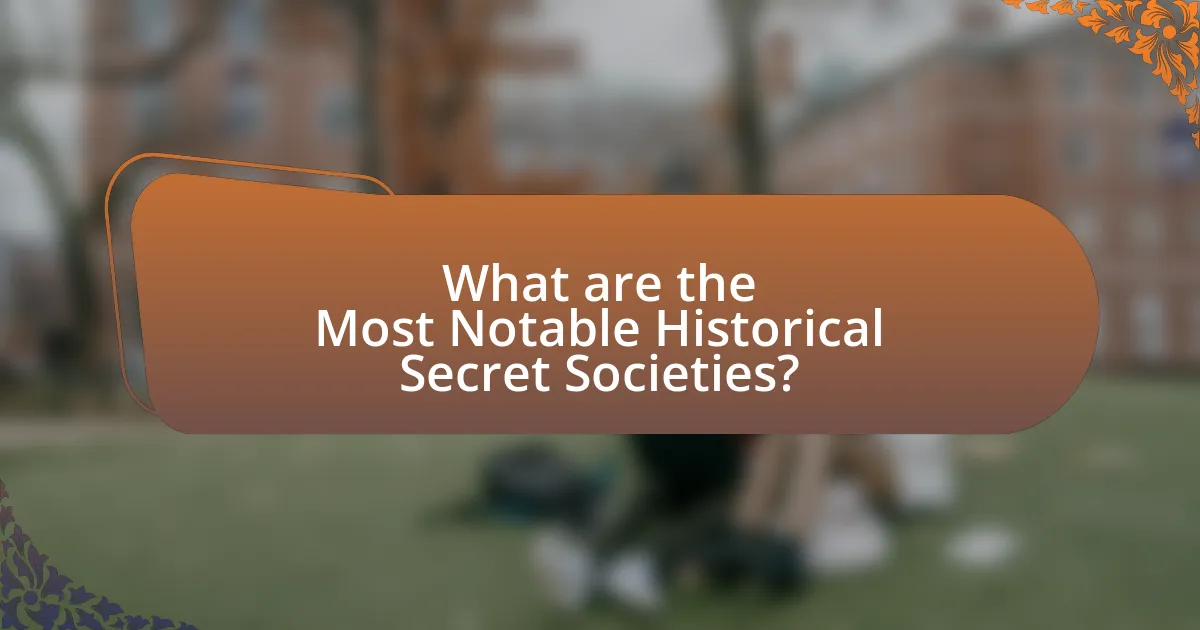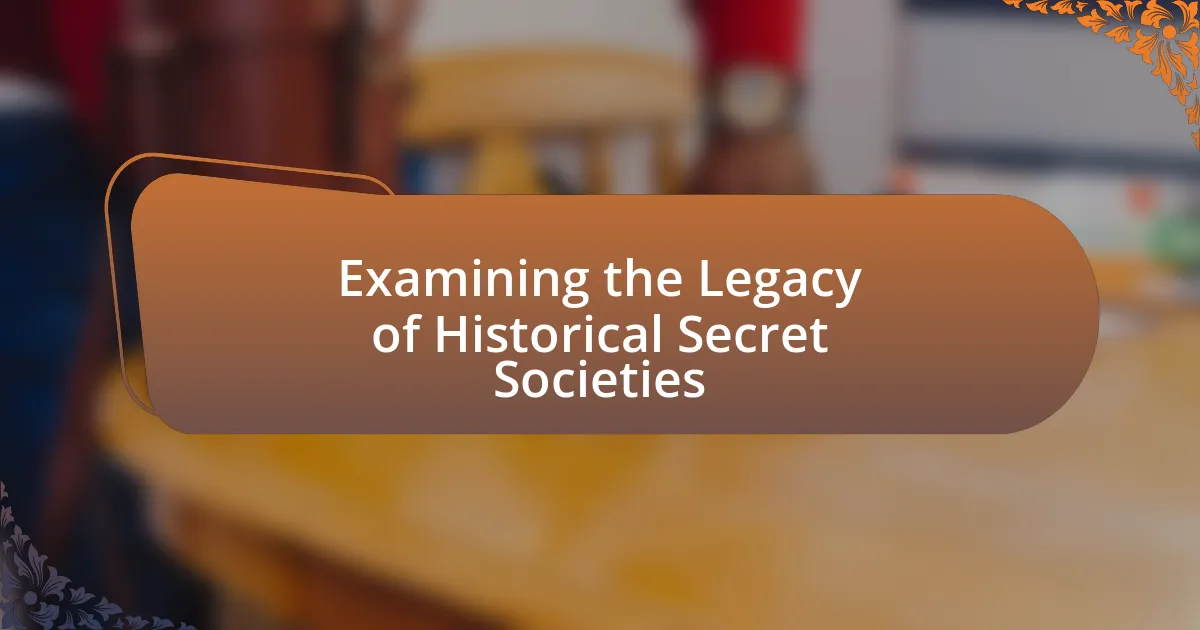Historical secret societies, such as the Freemasons, the Illuminati, and the Rosicrucians, have significantly influenced political, social, and cultural landscapes throughout history. These organizations emerged in response to oppression, promoting ideals of liberty and equality, and played pivotal roles in major events like the American and French Revolutions. The article examines their origins, key figures, and the roles they played in shaping societal norms and political movements, as well as their lasting legacies in contemporary culture and power dynamics. It also explores the common characteristics of these societies, including their rituals, symbols, and the impact of their secrecy on modern perceptions of power.

What are Historical Secret Societies and Their Significance?
Historical secret societies are organizations that operate in secrecy, often with exclusive membership and hidden agendas, significantly influencing political, social, and cultural landscapes throughout history. These societies, such as the Freemasons, the Illuminati, and the Rosicrucians, have played pivotal roles in events like the American and French Revolutions, promoting ideals of liberty, equality, and fraternity. Their significance lies in their ability to shape public discourse, mobilize collective action, and foster networks of influence that challenge established power structures. For instance, the Freemasons were instrumental in the founding of the United States, with many Founding Fathers being members, thereby embedding their principles into the nation’s foundation.
How did historical secret societies emerge?
Historical secret societies emerged primarily as a response to social, political, and religious oppression, often providing a means for individuals to share ideas and organize in secrecy. For instance, the Freemasons, founded in the late 16th to early 17th century, arose from the guilds of stonemasons and became a platform for Enlightenment ideals, promoting liberty and fraternity in a time of rigid social hierarchies. Similarly, the Illuminati, established in 1776 in Bavaria, sought to promote rationalism and secularism against the backdrop of religious influence in governance. These societies often utilized rituals and symbols to foster a sense of belonging and to protect their members from persecution, reflecting the historical context of their formation.
What social and political contexts contributed to their formation?
The social and political contexts that contributed to the formation of historical secret societies include widespread discontent with existing political structures and the desire for social reform. During periods of political upheaval, such as the Enlightenment and the American and French Revolutions, individuals sought alternative avenues for influence and change, often forming clandestine groups to discuss ideas and strategies away from oppressive regimes. For instance, the Freemasons emerged in the early 18th century as a response to the rigid class structures and authoritarian governance of the time, promoting ideals of liberty, equality, and fraternity. Similarly, the Carbonari in Italy formed in the early 19th century to advocate for national unification and democratic governance against foreign domination. These societies often operated in secrecy to protect their members from persecution and to facilitate the exchange of revolutionary ideas, demonstrating how social dissatisfaction and political repression directly influenced their establishment.
Who were the key figures involved in the establishment of these societies?
Key figures involved in the establishment of historical secret societies include Adam Weishaupt, who founded the Bavarian Illuminati in 1776, and George Washington, who was associated with the Freemasons. Weishaupt aimed to promote Enlightenment ideals through his society, while Washington’s involvement in Freemasonry helped shape the organization’s influence in early American society. Both figures played significant roles in the development and propagation of their respective societies, impacting political and social structures of their time.
What roles did historical secret societies play in society?
Historical secret societies played significant roles in shaping political, social, and cultural landscapes. These organizations often operated as networks for mutual support, influencing governance and societal norms through clandestine activities. For instance, the Freemasons, established in the late 16th century, promoted Enlightenment ideals and contributed to the American Revolution by fostering connections among influential figures like George Washington and Benjamin Franklin. Similarly, the Illuminati, founded in 1776, aimed to promote rationalism and secularism, impacting the discourse on governance and individual rights. Their influence extended to various revolutions and reform movements, demonstrating their capacity to mobilize individuals towards collective goals.
How did they influence political movements and revolutions?
Historical secret societies significantly influenced political movements and revolutions by providing a platform for like-minded individuals to organize, strategize, and disseminate revolutionary ideas. For instance, the Freemasons played a crucial role in the American Revolution by fostering Enlightenment ideals among its members, which included key figures like George Washington and Benjamin Franklin. Their networks facilitated the spread of revolutionary thought and coordinated efforts against British rule. Similarly, the Carbonari in Italy were instrumental in the Risorgimento, advocating for national unity and liberal reforms, which ultimately contributed to the unification of Italy in the 19th century. These societies often operated in secrecy, allowing them to evade government repression while mobilizing support for transformative political agendas.
What cultural impacts did they have on art and literature?
Historical secret societies significantly influenced art and literature by promoting themes of mysticism, symbolism, and social critique. For instance, the Freemasons inspired numerous artists and writers, leading to the incorporation of Masonic symbols in works by figures like Albert Pike and in the architecture of buildings such as the United States Capitol. Additionally, the Rosicrucians contributed to the literary movement of Romanticism, emphasizing individualism and the exploration of the subconscious, as seen in the works of authors like Goethe and Blake. These societies often served as catalysts for the exploration of esoteric knowledge, which enriched artistic expression and literary narratives, thereby shaping cultural discourse.

What are the Most Notable Historical Secret Societies?
The most notable historical secret societies include the Freemasons, the Illuminati, and the Rosicrucians. The Freemasons, established in the late 16th to early 17th century, are known for their fraternal organization and influence on various political and social movements. The Illuminati, founded in 1776 in Bavaria, aimed to promote Enlightenment ideals and has been associated with numerous conspiracy theories. The Rosicrucians, originating in the early 17th century, focused on esoteric knowledge and spiritual enlightenment. Each of these societies has left a significant mark on history, influencing cultural, political, and philosophical developments.
Which secret societies have had the most significant historical impact?
The Freemasons, the Illuminati, and the Rosicrucians are secret societies that have had significant historical impact. The Freemasons, founded in the late 16th to early 17th century, played a crucial role in the Enlightenment, promoting ideas of liberty and democracy, influencing the American and French Revolutions. The Illuminati, established in 1776, sought to promote rationalism and secularism, impacting political thought and conspiracy theories surrounding elite control. The Rosicrucians, emerging in the early 17th century, contributed to the development of esoteric knowledge and influenced various philosophical movements. Each of these societies has left a lasting legacy on political, social, and cultural developments throughout history.
What were the main objectives of the Freemasons?
The main objectives of the Freemasons include promoting moral and ethical development, fostering brotherhood among members, and supporting charitable activities. Freemasonry emphasizes the importance of personal integrity, community service, and the pursuit of knowledge. Historically, Freemasons have engaged in philanthropic efforts, such as funding hospitals and educational institutions, which underscores their commitment to societal improvement. The organization also seeks to provide a framework for members to explore philosophical and spiritual ideas, encouraging a quest for truth and understanding.
How did the Illuminati shape modern conspiracy theories?
The Illuminati significantly shaped modern conspiracy theories by serving as a foundational archetype for secretive organizations believed to manipulate global events. Established in 1776, the Bavarian Illuminati aimed to promote Enlightenment ideals but was quickly associated with various conspiracy theories, particularly after its dissolution in 1785. This association has led to the belief that elite groups operate behind the scenes to control governments and societies, influencing narratives around power and secrecy. The term “Illuminati” has since become synonymous with any perceived clandestine group, fueling speculation and distrust in institutions. This phenomenon is evidenced by the proliferation of literature and media that reference the Illuminati as a central figure in conspiracy theories, illustrating its lasting impact on public perception of secret societies.
What are the common characteristics of these societies?
Common characteristics of historical secret societies include exclusivity, ritualistic practices, and a focus on shared beliefs or goals. These societies often require members to undergo initiation processes that reinforce loyalty and secrecy. For example, the Freemasons utilize elaborate rituals and symbols to convey moral lessons and foster a sense of community among members. Additionally, many secret societies operate under a hierarchical structure, which facilitates the dissemination of knowledge and power among a select group. This exclusivity and structured approach contribute to their enduring influence and legacy in various cultural and political contexts.
What rituals and symbols are commonly associated with secret societies?
Rituals and symbols commonly associated with secret societies include initiation ceremonies, oaths of secrecy, and specific emblems like the skull and crossbones or the all-seeing eye. Initiation ceremonies often involve elaborate rites that signify the transition of a member into the society, emphasizing loyalty and commitment. Oaths of secrecy bind members to confidentiality, reinforcing the exclusivity of the group. Symbols such as the skull and crossbones, used by groups like the Freemasons, represent mortality and the importance of life choices, while the all-seeing eye symbolizes knowledge and enlightenment. These elements serve to create a shared identity among members and convey the society’s values and beliefs.
How do membership and secrecy function within these groups?
Membership in historical secret societies often functions through exclusive criteria that limit access to a select group of individuals, while secrecy serves to protect the group’s activities and knowledge from external scrutiny. These societies typically require potential members to undergo rigorous vetting processes, which may include recommendations from existing members, oaths of loyalty, and adherence to specific ideological or philosophical beliefs. Secrecy is maintained through rituals, coded language, and the use of symbols, which not only foster a sense of belonging among members but also create barriers to entry for outsiders. For example, the Freemasons utilize a system of degrees and secret handshakes to signify membership and maintain confidentiality, reinforcing the group’s cohesion and mystique.

How Do Historical Secret Societies Influence Modern Society?
Historical secret societies influence modern society by shaping cultural narratives, political ideologies, and social structures. For instance, organizations like the Freemasons and the Illuminati have historically been linked to the promotion of Enlightenment ideals, which emphasize reason and individualism, impacting contemporary democratic values. Additionally, the rituals and symbols of these societies often permeate popular culture, influencing literature, film, and art, thereby reinforcing their legacy in modern societal frameworks. The continued fascination with these groups in conspiracy theories also reflects their enduring impact on public perception and discourse, illustrating how historical secret societies continue to resonate in contemporary discussions about power and secrecy.
What legacies have historical secret societies left in contemporary culture?
Historical secret societies have left significant legacies in contemporary culture, particularly in the realms of symbolism, conspiracy theories, and social networks. For instance, symbols such as the Eye of Providence and the pentagram, associated with groups like the Freemasons and the Illuminati, continue to permeate modern art, literature, and popular media, often representing hidden knowledge or power. Additionally, the fascination with conspiracy theories surrounding these societies has influenced contemporary narratives in films and books, reflecting societal anxieties about secrecy and control. Furthermore, the social structures and networking practices established by these societies have evolved into modern organizations and clubs, promoting exclusivity and camaraderie, which can be seen in various elite groups today.
How are secret societies represented in modern media?
Secret societies are often represented in modern media as mysterious and influential organizations that wield significant power behind the scenes. This portrayal is evident in various films, television shows, and literature, where these groups are depicted as having hidden agendas, engaging in conspiracies, and manipulating political or social events. For instance, movies like “The Da Vinci Code” and series such as “The X-Files” showcase secret societies as central to the plot, emphasizing their enigmatic nature and the allure of uncovering hidden truths. This representation taps into public fascination with secrecy and the unknown, often blending fact with fiction to create compelling narratives that resonate with audiences.
What parallels can be drawn between historical and modern secret societies?
Parallels between historical and modern secret societies include their use of exclusivity, rituals, and influence on political or social structures. Historical secret societies, such as the Freemasons in the 18th century, often operated under a veil of secrecy to protect their members and advance specific agendas, similar to modern groups like the Bohemian Grove, which also maintain confidentiality while exerting influence over political and business leaders. Both types of societies utilize rituals to foster a sense of belonging and commitment among members, reinforcing loyalty and shared identity. Furthermore, both historical and modern secret societies have been accused of manipulating events behind the scenes, demonstrating a consistent pattern of seeking power and control through clandestine means.
What lessons can we learn from the legacy of historical secret societies?
The legacy of historical secret societies teaches us the importance of organization, shared values, and the impact of collective action. These societies, such as the Freemasons and the Illuminati, often influenced political and social change through their networks and ideologies. For instance, the Freemasons played a significant role in the American Revolution, promoting Enlightenment ideals that shaped democratic governance. Their structured approach to membership and rituals fostered loyalty and commitment among members, demonstrating how shared beliefs can mobilize individuals for a common cause. Additionally, the secrecy surrounding these societies highlights the power of information control and the potential for both positive and negative societal influence.
How can understanding these societies inform our view of power dynamics today?
Understanding historical secret societies can illuminate contemporary power dynamics by revealing how elite groups have historically influenced governance and social structures. For instance, the Freemasons and the Illuminati played significant roles in shaping political ideologies and institutions during pivotal moments, such as the Enlightenment and the American Revolution. Their practices of secrecy and networking demonstrate how informal alliances can wield substantial influence over public policy and societal norms. This historical context helps us recognize similar patterns today, where modern organizations and lobbyists operate behind the scenes to affect legislation and public opinion, thereby reinforcing the notion that power often resides in the hands of a few, rather than being evenly distributed among the populace.
What best practices can be derived from the historical actions of these societies?
Best practices derived from the historical actions of secret societies include the establishment of strong networks for mutual support and the promotion of shared values among members. These societies often thrived by fostering loyalty and trust, which facilitated collaboration on common goals. For instance, the Freemasons emphasized community service and philanthropy, which not only strengthened their internal bonds but also enhanced their public image. Additionally, the use of rituals and symbols helped to create a sense of identity and belonging, reinforcing commitment among members. Historical evidence shows that these practices contributed to the longevity and influence of such societies, demonstrating their effectiveness in achieving collective objectives.
